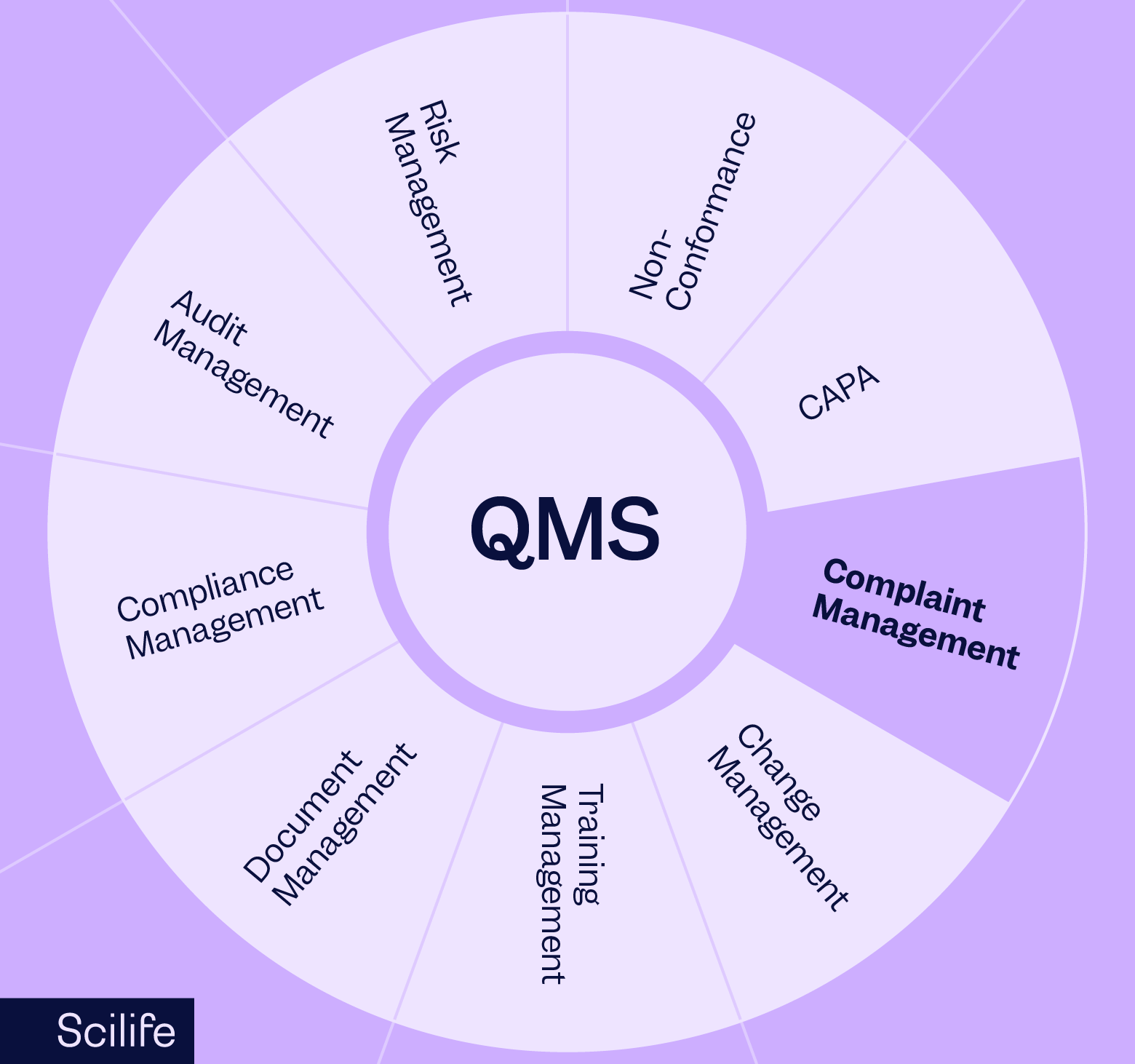
A Complaint Management System (CMS) is a software or procedural framework designed to efficiently handle and monitor customer complaints within a business. It facilitates the submission of complaints through various channels and tracks their progress. Additionally, a Complaint Management System also categorizes, prioritizes, and assigns complaints for timely resolution. CMS enhances communication between customers and corresponding support teams by automating notifications and capturing feedback. CMS enables organizations to identify trends, address recurring issues, and ultimately improve customer satisfaction and business performance by providing smart features for reporting and analytics.
A Complaint Management System is crucial for several reasons in the life sciences industry, where precision, compliance, and customer trust are paramount. First and foremost, it helps life sciences organizations adhere to regulatory requirements by providing a systematic approach to recording, tracking, and resolving complaints related to products or services. This is vital in an industry where regulatory compliance is stringent and noncompliance can have serious consequences. Additionally, a Complaint Management System enables life sciences organizations to swiftly address and rectify issues, ensuring the safety and efficacy of their products. It plays a pivotal role in maintaining and improving the quality of products and services by identifying recurring problems, facilitating continuous improvement initiatives, and bolstering overall customer satisfaction. In an industry where reputation is closely tied to trust and reliability, an effective Complaint Management System is indispensable for upholding high standards, regulatory adherence, and customer confidence.

Steps for building a complaint management system into your QMS
The first step in building a Complaint Management System into your QMS is to define a workflow to handle the complaints effectively. A typical Complaint Management System involves the following five key steps:

1. Receiving the complaint
You will need several channels including toll-free helpline numbers, WhatsApp, a website, or Customer Relationship Management Software for receiving customer complaints. Another important aspect to consider at the complaint-receiving stage is to ensure that your customers are aware of your channels for reporting the complaints. Once a customer complaint is received through any of these channels, you need to ensure that the complaint is duly reported in your QMS channel too. Therefore, you can create an automated workflow for the complaint transfer from all the channels to your QMS. Alternatively, you will have to enter every complaint manually in your QMS.
2. Tracking the complaint
After receiving the complaint, you will need to send an email to the customer to acknowledge the receipt of the complaint and notify the responsible customer service representatives for handling the complaint. Therefore, you will need a provision for tagging the complaint to track the status. Some examples of tags to track the complaint status include ‘New Complaint’, ‘Complaint Under Investigation, ‘Complaint Response’, ‘Complaint Closed’, etc. Every time the status of a complaint is changed, the corresponding date and time should be automatically captured in the system, and the customer should be notified about the status change. Tracking the complaint is also important for monitoring the performance of your Complaint Management System and to project manage the complaints internally.
3. Handling the complaint
Every time a new complaint is received, you will need to assure the customer that the complaint is being handled by responsible team members. Therefore, you should have an internal workflow for assigning the complaint to the responsible customer service representative depending on the customer's location, complaint prioritization, and the type of product or service to which the complaint relates. The customer should be notified about the name and contact details of the customer service representative who is assigned the complaint.
4. Reverting to the complaint
After the complaint is assigned to a customer service representative, they will communicate with internal and external stakeholders and revert to the customer with Corrective and Preventive actions taken up by the team and register feedback of the customer on his/her action plan.
5. Closing the complaint
After the complaint is assigned to a customer service representative, they will communicate with internal and external stakeholders and revert to the customer with Corrective and Preventive actions taken up by the team and register feedback of the customer on his/her action plan.
How to encourage incoming complaints and manage them effectively
Nobody likes to hear complaints, but if left unresolved they can turn into deeper issues, especially in the regulated sector like life sciences. Therefore the best way to deal with the complaints is to see them as an opportunity for improvement and address them positively. Below are some strategies to encourage incoming complaints and manage them effectively:
Make It Easy to Report Complaints Directly
It feels counterintuitive to encourage the reporting of complaints, but focusing on ease and transparency is one of the biggest steps you can take to improve your products or services. Therefore, there should be clear channels available for everyone who wants to report complaints to make the process faster and more straightforward. For example, the healthcare system in Australia has a nationwide Health Complaints Commissioner's Office dedicated completely to handling complaints in their sector, with online portals people can report complaints with ease.
Develop A Clear Process For Handling Complaints
Standardize the internal processes for handling incoming complaints. Create response templates for acknowledging the receipt of complaints, status changes, and other updates. It will harmonize organization-wide practices for handling complaints and also go a long way in pacifying the customers who made the complaints. Define clear roles and responsibilities for handling complaints according to the nature of the complaint, location, and priority.
Keep Communication Channels With Employees Open
Employees are sometimes the first to notice deviations and irregularities in a product. If employees are empowered to speak up, they can be your organization’s “first line of defense.” Companies that address employee observations and complaints also have higher retention rates.
Address Issues Quickly
In the regulated sector, the way your organization owns up to complaints and handles them will be under scrutiny. Every complaint should be followed with a root cause investigation and preventive and corrective action plan. Taking action quickly will reinforce the belief that you are caring and willing to meet the client’s needs.
Develop Proactive Management Practices
Proactive management strategies will help lessen the impact and overall number of future complaints.
Keep On Top Of Reviews And Mentions
Awareness of company presence online and in social media spheres will alert you to deviations and nonconformities in your products. Awareness is the first step to fixing problems before they grow bigger.
Reward Employees Who Succeed At Handling Complaints
Remember that it feels uncomfortable for your employees to log complaints or handle complaints on products or services they are responsible for. They may think it reflects negatively upon themselves or their work. Foster an environment of openness and transparency when dealing with complaints. This will normalize the actions of handling and reporting until employees accept complaint management as simply another step in quality assurance. Rewarding employees who do a spectacular job in handling a complaint or saving a client relationship is one way to reinforce these ideas.
Benefits of having a complaint management system
Implementing a complaint management system in the life sciences industry offers several benefits, contributing to improved product quality, regulatory compliance, and customer satisfaction. Here are some key advantages:
1. Regulatory Compliance
- Ensures adherence to industry regulations and standards, such as 21 CFR Part 280, Good Manufacturing Practice (GMP), and Good Laboratory Practice (GLP).
- Facilitates timely reporting of complaints to regulatory authorities, helping the company meet regulatory requirements.
2. Product Quality Improvement
- Enables systematic tracking and analysis of complaints, leading to the identification of root causes.
- Facilitates the implementation of corrective and preventive actions (CAPA) to address recurring issues, enhancing overall product quality.
3. Risk Mitigation
- Identifies potential risks and hazards associated with products, allowing for proactive risk management and mitigation strategies.
- Minimizes the likelihood of product recalls and associated financial losses.
4. Customer Satisfaction
- Demonstrates a commitment to customer satisfaction by promptly addressing and resolving complaints.
- Enhances the company's reputation for delivering high-quality products and services.
5. Efficient Communication
- Streamlines communication channels for receiving, documenting, and responding to complaints, ensuring a timely and efficient process.
- Enhances transparency in communication with customers and regulatory agencies.
6. Data-driven Decision Making
- Provides valuable data for trend analysis, helping management make informed decisions to prevent future issues.
- Enables the identification of patterns and emerging issues before they become widespread problems.
7. Continuous Improvement
- Supports a culture of continuous improvement by fostering a proactive approach to addressing customer feedback and implementing changes.
- Encourages the integration of lessons learned from complaint analysis into product development and manufacturing processes.
8. Legal Protection
- Offers legal protection by documenting and managing complaints in accordance with regulatory requirements.
- Provides a solid foundation for defending the company in case of legal challenges.
9. Resource Optimization
- Optimizes resource allocation by directing efforts towards areas with the highest impact on customer satisfaction and product quality.
- Reduces the time and resources spent on resolving recurring issues.
10. Competitive Advantage
- Differentiates the company from competitors by showcasing a commitment to quality and customer satisfaction.
- Can be a selling point in marketing and promotional activities.
Therefore, a robust complaint management system in the life sciences industry is essential for regulatory compliance, quality improvement, risk mitigation, and maintaining customer satisfaction, ultimately contributing to the overall success of the organization.
Conclusion
In conclusion, integrating a Complaint Management System into the Quality Management System involves defining a workflow, encompassing steps like receiving, tracking, assigning responsibilities, handling, reverting to the customer, and closing complaints.
Encouraging incoming complaints is vital for improvement. Ease of reporting, developing clear processes, keeping communication channels open with employees, addressing issues promptly, and implementing proactive management practices are essential strategies. Staying informed about online reviews and rewarding employees for effective complaint handling fosters a positive complaint management culture.
The benefits of having a Complaint Management System in the life sciences industry are diverse. It ensures regulatory compliance, improves product quality through analysis and corrective actions, mitigates risks, enhances customer satisfaction, streamlines communication, supports data-driven decision-making, fosters continuous improvement, provides legal protection, optimizes resources, and offers a competitive advantage.
In summary, a well-implemented Complaint Management System is indispensable for upholding high standards, regulatory adherence, and customer confidence in the life sciences sector. Beyond effectively addressing customer concerns, it contributes significantly to the overall success and sustainability of organizations within this highly regulated and competitive landscape.


